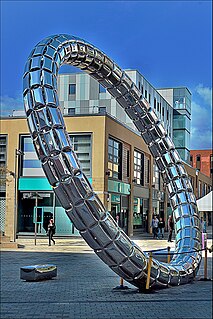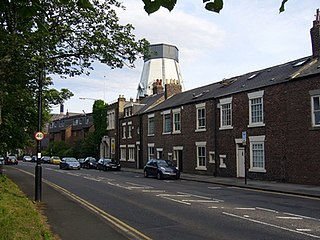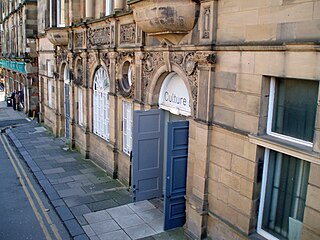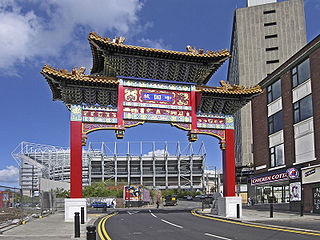This article needs additional citations for verification .(February 2014) |

The Newcastle Arts Centre is a fine and performing arts centre in Newcastle upon Tyne, England.
This article needs additional citations for verification .(February 2014) |

The Newcastle Arts Centre is a fine and performing arts centre in Newcastle upon Tyne, England.
The Newcastle Arts Centre was founded in July 1981 by Mike and Norma Tilley. The centre was formed in a block of seven abandoned buildings consisting of merchant houses, shops, warehousing and a former department store in Central Newcastle allowing for a mixed use development where some buildings could be rented out to help fund the provision of art space with a street level access that is integrated into the existing townscape. The Centre was designed with an eye toward maintaining the existing buildings and their identity within the community. After several years of funding and development, the Centre was officially opened by Prince Charles in 1988.
By the end of the 1980s, the Centre was home to Northern Stage and New Writing North, among other photography, audio, and visual arts productions.
The Centre also promoted a successful Edinburgh Fringe stopover programme and an annual professional craft fair. Newcastle Arts Centre has operated without revenue grant aid since 1993, supported by 82,000 visitors per year. [1]
The architectural innovation of the Newcastle Arts Centre was recognized with a Times/RIBA Community Enterprise Award. It was also the subject of a case study in Arts and the Changing City. [2]

Newcastle upon Tyne, or simply Newcastle, is a city and metropolitan borough in Tyne and Wear, England. The city is located on the River Tyne's northern bank and forms the largest part of the Tyneside built-up area. Newcastle is also the most populous city of North East England. Newcastle developed around a Roman settlement called Pons Aelius and the settlement later took the name of a castle built in 1080 by William the Conqueror's eldest son, Robert Curthose.

Tyne and Wear is a metropolitan county in North East England, situated around the mouths of the rivers Tyne and Wear. It was created in 1974, by the Local Government Act 1972, along with five metropolitan boroughs of Gateshead, Newcastle upon Tyne, Sunderland, North Tyneside and South Tyneside. It is bordered by Northumberland to the north and Durham to the south; the county boundary was formerly split between these counties with the border as the River Tyne.

Newcastle Central Station is a major railway station in Newcastle upon Tyne. It is located on the East Coast Main Line, around 268 miles (432 km) north of London King's Cross. It is the primary national rail station serving Newcastle upon Tyne, with local rail services provided by the Tyne and Wear Metro network to which the station is connected to by Central Station Metro station, situated beneath the national rail station.

Fenham is an area of the west-end of Newcastle upon Tyne, England. It lies to the west of the city centre, and is bounded on the north and east by a large area of open land known as the Town Moor. To the south lies Benwell, West Denton lies to the west, Blakelaw and Cowgate to the north, and Arthur's Hill and Spital Tongues to the east.

The Byker Wall is a long, unbroken block of 620 maisonettes in the Byker district of Newcastle upon Tyne, England. They were designed by Ralph Erskine and constructed in the 1970s. The wall is just part of the estate, which in total covers 200 acres.

Seven Stories, the National Centre for Children's Books is a museum and visitor centre dedicated to children's literature and based in the Ouseburn Valley, Newcastle upon Tyne, close to the city's regenerated Quayside. The renovated Victorian mill in which it is housed has seven levels. It is the first and only museum in the UK wholly devoted to the art of British children's books. Their archive is housed in a separate building in Felling.

Newcastle College is a large further education and higher education college in Newcastle upon Tyne, with more than 16,000 students enrolled each year on a variety of full time, part time, and distance learning. It is the largest further education college in the North East of England and one of the largest in the United Kingdom.

The Quayside is an area along the banks (quay) of the River Tyne in Newcastle upon Tyne and Gateshead in Tyne and Wear, North East England, United Kingdom.

The Blue Carpet is a piece of public art in Newcastle-Upon-Tyne, England, designed by Thomas Heatherwick. It is an area of public open space in front of the Laing Art Gallery, close to the main shopping and nightclub areas, paved with glass-and-resin slabs which curve up at the space's edges, giving the appearance of a fabric carpet. Although classified as a piece of public art, it is closer to an urban design feature.

Trinity Square is a shopping and leisure centre in Gateshead, Tyne and Wear, England. The new centre was constructed on the site of former multi-storey car park and shopping complex going by the same name, which originally opened in 1967.

Haymarket is an area in the north of central Newcastle upon Tyne. The area has several transport hubs including Eldon Square bus station, Haymarket bus station and Haymarket Metro station. Haymarket features the facades of Newcastle Civic Centre, Newcastle University and Northumbria University. It is also the location of the Church of St Thomas the Martyr, a prominent city landmark.

Spital Tongues is a district of Newcastle upon Tyne, located due north-west of the Newcastle City Centre. Its unusual name is believed to be derived from spital – a corruption of the word hospital, commonly found in British place names - and tongues, meaning outlying pieces of land. North of Spital Tongues is Leazes Park and the Town Moor.

South Shields railway station was the main railway station for South Shields, in Tyne and Wear, North-East England. The station was located on Mile End Road in the town centre. The station was opened by the NER in 1879 as the terminus of their newly extended Newcastle and South Shields Railway branch from Pelaw via Hebburn and had two platforms and an ornate overall roof.

Grainger Town is the historic commercial centre of Newcastle upon Tyne, England.

Culture Lab is an interdisciplinary research facility at Newcastle University, Newcastle upon Tyne, UK.

The Tyne Theatre and Opera House is a theatre in Newcastle upon Tyne, England. It is a Grade I listed building[1], rated "in the top 4% of listed buildings" by English Heritage and is afforded a three star rating by the Theatres Trust, "a very fine theatre of the highest theatrical and architectural quality". It opened in 1867 as the Tyne Theatre and Opera House, designed by the Newcastle upon Tyne architecture practice of William Parnell. The backstage area was damaged by fire in 1985, with subsequent rebuilding restoring the Victorian stage machinery.

Newcastle University Boat Club (NUBC) is the rowing club of Newcastle University, UK. Established in March 1911 as the boat club for Armstrong College, it celebrated its centenary in 2011, when was also appointed High Performance Programme for heavyweight men and women by British Rowing. In the past 20 years current students and alumni won 60 international vests for GB.

The People's Theatre is an amateur theatre in Newcastle upon Tyne, England. Originally located in the city centre, the People's Theatre moved to its current site, adjacent to the Coast Road in Heaton, in 1962. It shows approximately 13 productions a year including a full-scale family pantomime.

The Chinatown in Newcastle is a district of Newcastle upon Tyne, located in the west of the city, on the edge of the shopping and commercial centre, along Stowell Street. It is one of five Chinatowns in England, with the other four being in London, Birmingham, Manchester, and Liverpool.

Newcastle Great Park is a new suburb in the north of Newcastle upon Tyne, England. Much of Newcastle Great Park is still under development and is sandwiched in between older areas of Newcastle, namely Gosforth, Fawdon and Kingston Park to the south, and Hazlerigg to the north. Newcastle Great Park is the largest housing development in the North East of England.
Coordinates: 54°58′12.3″N1°37′4.8″W / 54.970083°N 1.618000°W